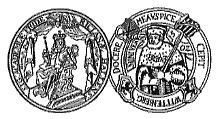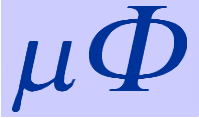

Martin-Luther-University Halle-Wittenberg | Max Planck Institute of Microstructure Physics
Department of Physics | Center of Materials Science


The Graduiertenkolleg is finished. There are no more PhD positions available.
Investigation of the interaction between the formation of secondary phases and the defect equilibrium in acceptor- and donor-doped BaTiO3 ceramics
Quanming Song (until October 2000) / Cristina Marcu (until November 2001)
Supervisor:
Dr. T. Langhammer / Prof. Dr. Hans-Peter Abicht
The electrical properties of BaTiO3 ceramics are essentially influenced by the defect chemistry. Kind of majority and minority defects can be adjusted substantially by the physical and chemical sintering conditions. In this way, the electrical conductivity (up to 1400 ?C) depends on the oxygen partial pressure and the composition of the liquid phases during the sintering process. Different methods of integral and locally resolved analysis should be applied to reveal the mechanisms. Especially the point defects near grain boundaries and in core shell grain structures are to be investigated.
Optical characterization of misfit dislocations in ZnSe layers and their relation to the strain relaxation
Uwe Hilpert (until January 2001)
Supervisor:
Dr. Jürgen Schreiber
Microscopic information on the optical properties of polar dislocations in ZnSe epitaxial layers on GaAs substrates is obtained by micro-cathodoluminescence and photoluminescence techniques. The polarization properties of the luminescence radiation is studied and related to the particular structural configuration of dislocations. The anisotropic relief of the strain of the layers is to be connected with the dislocation structure.
Defect structures at the interface of atomic-bonded semiconductor wafers
Norbert Engler
Supervisor:
Prof. Dr. Ulrich Gösele / PD Dr. Hartmut S. Leipner
The diffusion on the As sublattice of GaAs is studied by means of sulfur. Of special interest are rather low diffusion temperatures in order to clarify the diffusion mechanism of impurities on the As sublattice. Sulfur is in-diffused with different concentrations in order to achieve diffusion under equilibrium and non-equilibrium conditions. It is expected that a direct access to the selfdiffusion of arsenic is reached in this way.
Investigation of mechanic properties of semiconductor material with different point defect concentrations using indenter methods in a micro- and nanoscale
Dirk Lorenz (until September 1998)
Supervisor:
Prof. Dr. Peter Grau / PD Dr. Hartmut S. Leipner
The point defect concentration in GaAs and Si single crystals is adjusted in a contolled manner by doping and irradiation. The change in the mechanical properties introduced in this way, especially the transition from brittle to plastic deformation, can be studied by point loading experiments. Aim is the determination of the generation stress and the activation parameters of the generation of dislocation in dislocation-free regions.
Investigation of equilibrium defects in III-V compound semiconductors after annealing under defined vapor pressure
Konrad Petters
Supervisor:
Prof. Dr. Reinhard Krause-Rehberg / PD Dr. Hartmut S. Leipner
GaAs of different conduction type is contaminated by Cu. The diffusion and the formation of defects is studied by positron annihilation. Especially, the association of copper with diffusion-induced point defects and point defect clusters is investigated. In addition to the positron studies, transmission electron microscopy investigations and Hall effect measurements are carried out. A model related to the- in and out-diffusion of copper is developed.
Microprocesses of plastic and ferroelastic deformation of zirconium dioxide single crystals
Alexandr Tikhonovsky (until April 2001)
Supervisor:
Prof. Dr. U. Messerschmidt
Investigations of the mechanisms of deformation of zirconium crystals are carried out by macroscopic deformation tests, transmission electron microscopy and in situ straining tests in the high-voltage electron microscope.
Rastersondenmikroskopie an BaTiO3-Keramiken
Torsten Doege
Supervisor:
Prof. Dr. Henning Neddermeyer
Aim of the work is the characterization of grain boundaries in BaTiO3 ceramics by means of locally resolved luminescence spectroscopy. For this purpose, a scanning tunneling microscopy working at low temperatures is built up. This microscope should allow the simultaneous registration of emitted photons and the locally resolved spectroscopy. It has been already known from cathodoluminescence investigations that grain boundaries in this ceramic material exhibit a gain boundary contrast in the intensity of the photon emission. This has been interpreted as the accumulation of defects at the grain boundaries. Because the spatial resolution of cathodoluminescence is not very high (in micrometer range), no differences have been found so far in the spectra at the grain boundaries and in the grains. The possible higher resolution in scanning tunneling microscopy may provide information about the distribution of defects in the nanometer range, what is a great step forward against previous approaches. This may contribute to a better understanding of electrical transport properties.
Generation of point defects by dislocation motion
Christian G. Hübner (until December 1998)
Supervisor:
PD Dr. Hartmut S. Leipner / Prof. Dr. Reinhard Krause-Rehberg
The influence of the motion of dislocations during plastic deformation of semiconductor single crystals on the generation of different types of point defects is investigated. The combination of the analysis of macroscopic deformation data with spectroscopical and microscopic techniques is used to elucidate the interaction between zero- and one-dimensional crystal imperfections. The questions how a diffusion step is part of dislocation glide and how vacancies and interstitials are produced during deformation by dislocation jogs are treated.
Versetzungsgeneration in verspannten Halbleitermaterialien
André Zeckzer
Supervisor:
Prof. Dr. Peter Grau / PD Dr. Hartmut S. Leipner
Nanointentation and scratching techniques are used to study plastic and elastic properties of strained semiconductor structures. The aim is to gain a better understanding of the mechanisms of dislocation generation in thin epitaxial layers. The processes of anisotropic strain relaxation are studied in combination with three-point bending experiments. The measurement of the internal strain should allow to draw conclusions on the dislocation dynamics in thin layers. For this purpose, the connection between the so-called pop-in effect and the nucleation of glissile disloctions is used.
Analytical electron microscopy of defect structures in semiconductors
Dr. Jürgen Neumann-Zdralek (until October 2001) / Dr. Stefan Eichler (until December 1998)
Supervisor:
Prof. Dr. Hans-Reiner Höche / PD Dr. Hartmut S. Leipner
Main emphasis is put on high resolution analytical investigations of individual defects and graded semiconductor layers with the VG HB501UX scanning transmission electron microscope. The experiments are carried out in combination of energy-dispersive X-ray analysis, electron energy loss spectroscopy, and Z contrast imaging.
Versetzungsinduzierte Ladungsträgerrekombination und Versetzungsdynamik in Verbindungshalbleitern
Lutz Höring (until January 2001)
Supervisor:
Dr. Jürgen Schreiber
In different III-V and II-VI materials, such as GaAs and CdTe, radiative and non-radiative recombination processes at fresh glide dislocations are investigated by means of spectrally and locally resolved low temperature cathodoluminescence measurements in the scanning electron microscope. Recombination enhanced defect motion is studied in situ. New insight in intrinsic electronic properties of dislocations, especially in the role of kinks as recombination centers, is expected.
Localized electromagnetic modes in photonic crystals
T. V. Chandra Sekar
Supervisor:
Prof. Dr. Wolfram Hergert
Defect structures in photonic crystals are very important for the manufacturing of new optolectonic devices. The influence of defects on the photonic band structure and the photonic density of states of 2D and 3D photonic crystals is studied. It is of particular interest, how such defect structures can be utizilized for the control of photonic elements by electo-optical and magneto-optical effects.
Investigation of the defect chemistry of GaAs
Vladimir Bondarenko
Supervisor:
Prof. Dr. Reinhard Krause-Rehberg
The systematic investigations of the adjustment of equilibrium defects in III-V compounds (GaAs, InP) are continued. The defect equilibrium is adjusted by the control of the temperature and the external vapor pressure of one of the components (As, P). The structure and the concentration of equilibrium defects are elucidated by means of positron annihilation accompanied by optical (infrared absorption) and electrical measurements (Hall effect).
Analytical electron microscopy of device structures
Jingmin Zhang
Supervisor:
PD Dr. Hartmut S. Leipner / PD Dr. D. Hesse
Investigation of the correlation of electronic and dynamic dislocation properties in compound semiconductors
Serhiy V. Vasnyov
Supervisor:
Dr. Jürgen Schreiber / Prof. Dr. G. Dräger
High-temperature deformation of GaAs
Vladimir Mikhnovich
Supervisor:
PD Dr. Hartmut S. Leipner / Prof. Dr. Peter Grau
Growth of siliconnanowires by molecular beam epitaxy
Luise Schubert
Supervisor:
PD Dr. Hartmut S. Leipner
|
© This page has been updated by the webmaster on November, 17 2005.
Today is Friday, April 26, 2024. http://www.cmat.uni-halle.de/gk415 |
|